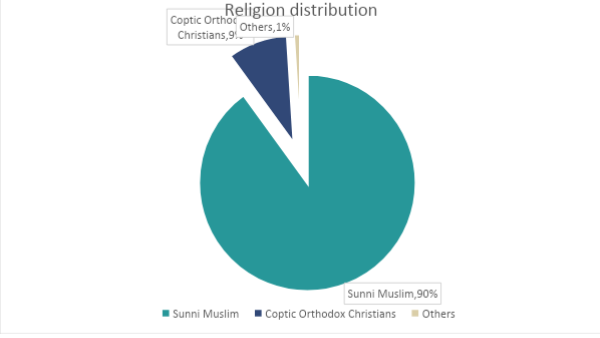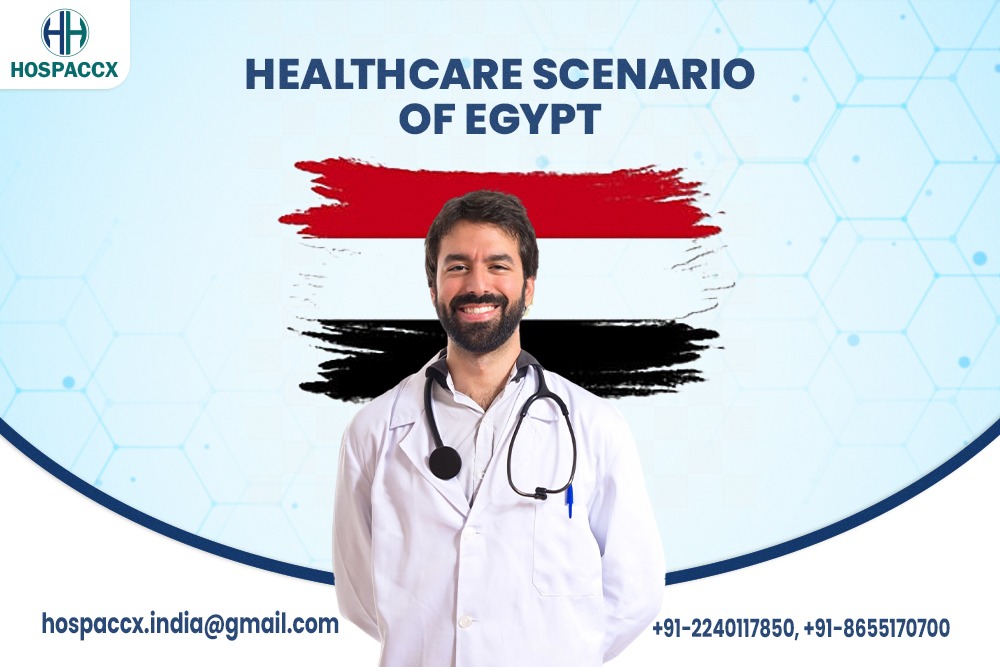Are you considering embarking on healthcare ventures in Egypt, whether it’s building, restructuring, or venturing into new setups? Seeking insights into the major healthcare stakeholders, including government institutions and private diagnostic centers across Egypt’s cities? Hospaccx Healthcare Consultancy presents a comprehensive mapping of Egypt’s medical landscape, shedding light on the prominent players and healthcare scenarios across the country. Whether you’re exploring optimal locations or planning facilities for a new venture, this article serves as your guide to navigating Egypt’s dynamic healthcare sector.
Egypt holds a significant position in the Middle East and North Africa, boasting a strong economy and a strategic location. With a growing workforce and a well-educated population, the country presents attractive opportunities for various businesses, including healthcare. The expanding middle class, which constitutes a considerable portion of the population, is fueling the demand for high-quality healthcare services. Cairo, the capital and largest city, serves as the hub for economic and healthcare activities, blending modern infrastructure with historical allure. As Egypt progresses, there are ample opportunities for healthcare ventures, drawing interest from both local and international investors looking to explore its thriving market.
| Population | 105.858mn on Jan 1 |
| Sex Ratio | 49.4% Females |
| Ethnicity | Egyptian 99.7%, other 0.3% |
| Literacy | 75% |

Economy
Egypt has outpaced neighbouring countries in economic growth, despite recent challenges such as soaring inflation and tightened financing conditions due to foreign currency shortages. To address these issues, Egypt is intensifying economic reforms, aiming for a more flexible exchange rate and targeted monetary policies to curb inflation. High public debt poses vulnerability to external shocks, underscoring the importance of implementing a credible consolidation strategy to restore fiscal health. Egypt plans to expand cash transfers to vulnerable groups while gradually phasing out broad-based energy subsidies to reduce emissions. Public investment has surged, with efforts needed to rationalize projects and prioritize green investments. Reviving private sector growth requires reducing regulatory burdens and implementing ongoing reforms effectively, including divestment plans. Integrating younger generations into the labor market hinges on reducing labor taxation, improving public employment support, and aligning skills with market needs.
In terms of growth projections, GDP growth is expected to decline to 3.2% in the fiscal year 2023/24 but is anticipated to rebound thereafter. The IMF forecasts a 3.0% increase in real GDP and a significant 32.5% rise in consumer prices for the year 2024.
Connectivity
Connectivity in Egypt is primarily facilitated through air travel, with Cairo International Airport serving as the central hub. Additional airports such as Hurghada International Airport, Sharm El Sheikh International Airport, Luxor International Airport, and Aswan International Airport cater to various regions and tourist destinations across the country.
Main Cooperates in Egypt
| Rank | Name | Market cap ($) | Sector |
| 1 | Commercial International Bank (Egypt) S.A.E. | $7.8B | Banking |
| 2 | Misr Fertilizer Production Company | $5.19B | agricultural chemical industry |
| 3 | Abu Qir Fertilizers and Chemical Industries Co. (S.A.E.) | $3.63B | agricultural chemical industry |
| 4 | Talaat Moustafa Group Holding | $2.87B | Real Estate |
| 5 | QNB Alahli S.A.E | $2.74B | Banking |
Growth Plan for Egypt
Egypt’s developmental plans for the upcoming years focus on key pillars such as constitutional entitlements, Egypt Vision 2030, and structural reforms.
Goals include achieving a growth rate of 4.2% and addressing challenges like rapid population growth. Strategies prioritize education, skills development, and innovation for improved living standards.
Economic aims for the new presidential term (2024- 2030) target balanced growth between 6 to 8 percent, with alignment to the OECD Egypt Country Programme emphasizing strategic objectives and priorities.
Plans for Healthcare
Egypt is making significant strides in healthcare development, with plans to increase spending to EGP 75 billion by FY 2023/24. This commitment aims to ensure comprehensive healthcare for all citizens and uplift living standards. The investment will cover various initiatives, including upgrading existing hospitals, commissioning new ones, and equipping medical centers and units. Additionally, strategic projects like the Medical City Nasser Institute and environmental system improvements are underway to enhance healthcare infrastructure and services.
Disease Burden
Most deaths are caused due to non-communicable diseases. The most common cause of death in Egypt are;
- Ischemic heart disease
- Cirrhosis liver
- Stroke
- Road injuries
- Chronic kidney disease
- Hypertensive heart disease
- Lower respiratory infect
- Diabetes
- COPD
- Liver cancer
Its crucial to note that Egypt has highest cases of Hepatitis C in the world.
Health statistics
| Health Expenditure | EGP 75B |
| Total Fertility Rate | 2.85 |
| Crude Birth rate | 21/1000 population |
| Infant Mortality Rates | 25 deaths/1000 Birth |
| Crude Death Rate | 7.3 |
| Life Expectancy | 67.2(M) & 72-2 (F) |
| Physician Density | .7 / 1000 |
| Bed Density | 13.3/10000 |
| Out of Pocket Expenditure | 56% |
Healthcare Service Providers
In Egypt, the government and semi-government sectors hold significant sway over the healthcare market, controlling specialized medical centres and entities like railways and universities, making up 72% of total beds. Despite the private sector owning 63% of hospitals, it faces challenges with only average of 31 beds per hospital compared to 96 beds in government and 209 semi-governmental hospitals. This fragmentation presents opportunities for integration through mergers and acquisitions, particularly as the private healthcare sector holds promising prospects for developers, investors, and operators. Challenges include high capital costs and the migration of skilled medical staff.
Healthcare Payment
Under the current system, all Egyptians can access care through public hospitals. However, due to understaffing and underfunding in many public facilities, Egyptians often choose to pay for private care out-of-pocket whenever possible.
Egypt’s new universal health insurance system is set to be operational by 2027, ahead of its original 2032 target due to early achievements. The comprehensive coverage will include medical examinations, tests like X-rays and scans, treatments, and surgeries.
Funding for the system will be sourced from citizen and employer premiums, a general tax, a tobacco product tax, and healthcare co-payments. Annual individual contributions are estimated between EGP 1,300 to EGP 4,000 (USD $70 to $212), with government subsidies for the needy. This initiative aims to alleviate high out-of-pocket expenses for healthcare.
Top Government Institutions/ Hospitals
-
Cairo University Hospitals: 3,842 Beds
At Cairo University, several hospitals operate, including Al-Manial University Hospital and Cairo University Children Hospital (Japanese). Across Cairo University hospitals, the total number of beds amounts to approximately 3,842 beds. Moreover, Cairo University’s Faculty of Medicine encompasses more than 5,200 beds, positioning it as one of the largest medical institutions in the Middle East.
-
Ain Shams University Hospitals: 3,200 Beds
Situated in Cairo, Ain Shams University oversees multiple hospitals with a collective capacity of around 3,200 beds. Within the Faculty of Medicine at Ain Shams University, four hospitals are integrated, boasting a total of 3,497 beds.
-
Mansoura University Hospitals: 365 Beds
Mansoura University Hospital has a bed capacity of 365 beds. Additionally, the Department of Internal Medicine at Mansoura University Hospital is equipped with 110 beds.
-
Alexandria University Hospitals: 3497 Beds
At Alexandria University, comprehensive services are offered to students, faculty members, and staff. The main hospital boasts over 200 beds, multiple operating rooms, an intensive care unit, and a state-of-the-art Physical Therapy unit equipped with the latest machinery and capabilities. Furthermore, the Alexandria Faculty of Medicine comprises four hospitals, collectively providing a total of 3,497 beds
Top Private/Semi Government Hospitals
-
Cleopatra Hospital Group: 1200 Beds
Cleopatra oversees 1,200 beds across all its facilities.
-
Alameda Healthcare:1000 Beds
Alameda boasts approximately 1,000 beds across 128 clinics, four hospitals, a home healthcare brand, and eight centres of excellence.
-
Arab Contractors Medical Centre:350 Beds
located in Nasr City, Egypt, has been serving patients since its establishment in 1981. With a capacity of 350 beds, it offers comprehensive healthcare services across multiple specialties.
-
New Kasr El Aini Teaching Hospital: 3200 Beds
situated in Cairo, Egypt, has been dedicated to patient care since its inception in 1996. With a substantial capacity of 3,200 beds, it provides a wide range of healthcare services across various specialties.
-
Saudi German Hospital: 300 Beds
located in Cairo, Egypt, commenced its operations in 2016. With a capacity of 300 beds, it offers a diverse array of healthcare services across multiple specialties.
-
As-Salam International Hospital: 350 Beds
based in Cairo, Egypt, was founded in 1982. Boasting a capacity of 350 beds, it provides a wide range of healthcare services to its patients.
Major Diagnostic Centres
- Techno Scan
- NSA Diagnostic Laboratories
- Cairo Diagnostics
- LifeLabs
Medical Tourism:
The initiative “We Take Care of You in Egypt” by the Medical Tourism Agency was introduced to entice international visitors to seek treatment in the agency’s hospitals.
Egypt possesses significant potential in the medical tourism sector, with its stunning beaches, sandy landscapes, and favorable weather conditions. However, there is a pressing need for enhanced publicity and improved logistical support to fully harness these advantages.
According to a tourism expert, numerous hotels and resorts along the Red Sea have recently incorporated hospitals and medical facilities into their establishments. This trend has been particularly successful in destinations like Hurghada, where a significant number of elderly German tourists visit for medical treatment.
Furthermore, the therapeutic qualities of locations such as the Siwa Oasis in the western desert, renowned for its healing sands and salt lakes, as well as sulfur baths in Oyun Musa, offer unique opportunities for medical tourism. Egypt’s proficiency in alternative medicine, including herbal remedies, presents another avenue for the development of innovative therapeutic programs that can be effectively promoted across various platforms.
conclusion
Egypt’s healthcare scene is a mix of challenges and possibilities. While it faces issues like uneven distribution of resources and limited access, recent efforts show promise for improvement. By working together, embracing technology, and ensuring fair access for all, Egypt can pave the way for a healthier future.
if you need any support in planning and designing of a new hospital you can contact us: Hospaccx healthcare business consulting Pvt. Ltd on: hospaccx.india@gmail.com. Or you can visit our website http://www.hospaccxconsulting.com/
Related Team Members











